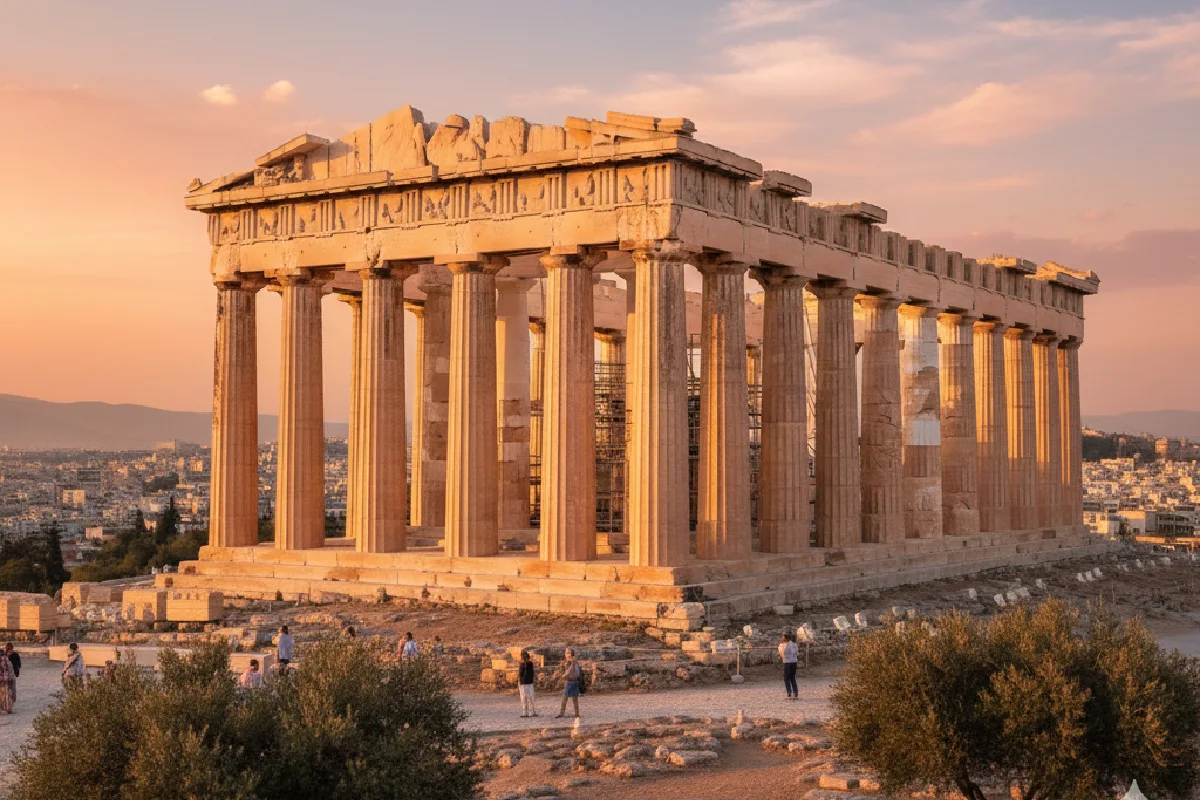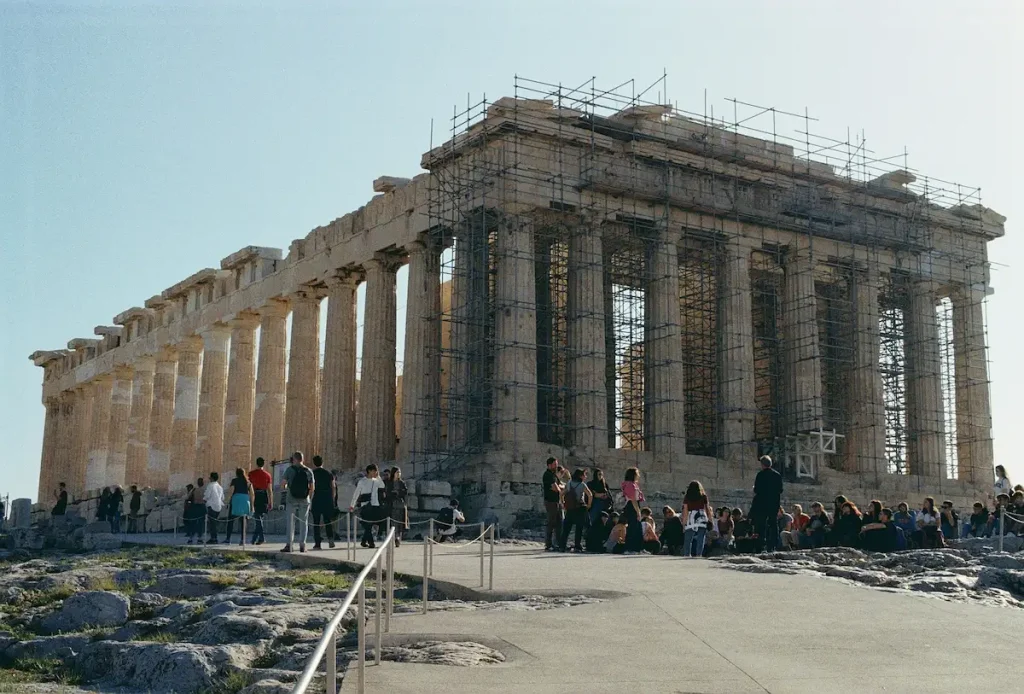
Date published: October 15, 2025
This October 2025, Athens is witnessing a significant event: the Parthenon stands completely free of scaffolding for the first time in two centuries. This new view of the Acropolis as a whole marks a turning point in one of the most ambitious conservation projects in modern history.
The image of the Parthenon wrapped in metal structures has become so familiar that several generations have grown up without ever seeing the monument in its full splendor. The western facade was covered by scaffolding for approximately 20 years, a continuous presence that had become a natural part of the Acropolis landscape.
However, the situation is even more extraordinary than it seems. As Lina Mendoni, the Greek Minister of Culture, pointed out, although the west facade had been hidden for two decades, this is the first time in about 200 years that the entire exterior of the monument is free of any type of scaffolding on all its facades.
This highlights something that might have been overlooked: the Parthenon has been under practically continuous restoration since the early 19th century. From the restoration of the eastern facade between 1984 and 1991 to the current works, the temple has undergone successive interventions in different sections. Each phase of work required scaffolding in a specific area, so the monument as a whole had never been completely cleared.

There are several factors behind this long-standing presence of scaffolding. The phase that has just concluded on the western facade aimed to correct the severe damage caused by previous restorations. Yes, we are talking about the renovation of the renovation.
The problem dates back to the interventions carried out by engineer Nikolaos Balanos between 1922 and 1933. During that time, iron clamps and bolts were used extensively to join the marble blocks. A solution that seemed adequate at the time turned out to be catastrophic in the long run, as the iron rusted and expanded, causing a phenomenon known as “rust jacking” that fractured the marble from within.
Recent work has focused on:
The operation is officially described as a “rescue” intervention, underscoring the urgency of acting before the damage became irreparable.
But we cannot get too excited; the clear view of the Parthenon is, unfortunately, a temporary interlude. The Greek authorities have been transparent about this: the period without scaffolding will last approximately one month, ending in November 2025.
Starting in November 2025, a new scaffolding structure will begin to be erected on the western facade to commence the final phase of the exterior works. However, there will be a notable difference: the new scaffolding will be “lighter and aesthetically much closer to the logic of the monument,” designed to minimize its visual impact.
This final phase is projected to last until the beginning of summer 2026. Minister Mendoni has promised that, once this work is concluded, “the Parthenon will be completely free of this scaffolding as well, and people will be able to see it truly free”.
But the story doesn’t end there. Parallel to the exterior work, an even more ambitious project is being carried out inside the temple: the partial restoration of the cella, the sacred chamber that originally housed the colossal statue of Athena. This project, approved by the Central Archaeological Council of Greece (KAS), has an estimated duration of 15 years and aims to:
This project represents a philosophical shift: moving from the mere preservation of a ruin to a partial reconstruction that restores the experience of the architectural space.
In terms of major structural interventions, yes. The conclusion of the exterior work in 2026 will mark the end of the main restoration phases of the current program, which began in 1975.
However, the conservation of the Parthenon is, by its nature, a perpetual commitment. The monument will continue to require ongoing maintenance, monitoring, and minor interventions to ensure its survival. We are talking about a building that is approximately 2,450 years old, so it is crucial to carry out these actions periodically. The difference is that, after 2026, these tasks can be performed without the need for large scaffolding structures enveloping the temple
The Parthenon has undergone multiple restoration cycles throughout its modern history. Each one reflects the understanding and technical capabilities of its time.
Directed by archaeologists Kyriakos Pittakis and Rizos Rangabé, these were the first interventions after Greek independence in 1830. The temple was cleared of later additions, such as the small Ottoman mosque that occupied its interior, and partial anastylosis was performed to present the monument as a symbol of Greek national identity.
An extensive program that reconstructed a large part of the Parthenon, reinstalling columns and architectural blocks. Balanos used cement and iron clamps, establishing the familiar image of the monument in the 20th century. In the 1920s, he completely rebuilt the north colonnade. Although these interventions restored some structural integrity, the use of unprotected iron caused serious damage over time.
The first phase of the modern scientific restoration program, focused on repairing structural damage from the 1981 earthquake. It included the dismantling and reassembly of the corners, the rotation of the southeast corner column, and the replacement of original sculptures with copies.
A program aimed at addressing structural instability caused by fire damage and past interventions. It included the dismantling of columns, injection of special grouts into burnt marble, and carving of flutes on new supplements.
In 1975, the Greek State created the Committee for the Conservation of the Acropolis Monuments (ESMA), initiating a new era of scientific restoration. The work began in 1983 and has covered practically all areas of the monument for over 40 years. This program established new international conservation standards:
Initiated in 2011, this phase focuses on the “rescue” operation of the western pediment to remove the iron clamps from Balanos’s intervention, stabilize the structure, and complete the final exterior details. Its completion in 2026 will mark a historic milestone: for the first time in centuries, the Parthenon can be appreciated fully stabilized, displaying its classical proportions without the support of scaffolding.
The Acropolis ticket grants visitors access to the archaeological site of the Acropolis and its slopes, including the Parthenon, the Theater…
The Acropolis of Athens is a testament to the rich history and culture of Greece and Western civilization. Over the centuries…
